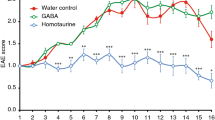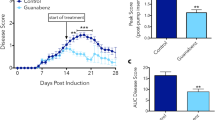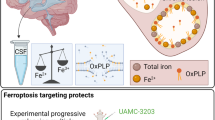Abstract
In multiple sclerosis (MS) and its animal model experimental autoimmune encephalomyelitis (EAE) the cytokines tumour necrosis factor-α (TNF), lymphotoxin-α (LT), and interferon-gamma (IFN-γ) are of central pathogenetic importance. A therapy capable of stopping neurological deterioration in MS patients is not yet available. Here, we report that rolipram, a selective type IV phosphodiesterase inhibitor, stereospecifically suppresses the production of TNF/LT and less strongly also IFN-γ in human and rat auto-reactive T cells. Moreover, we show that rolipram is an effective treatment for EAE. Rolipram has extensively been studied in humans for the treatment of depression, but has not yet been marketed. The data presented here identify rolipram as potential therapy for multiple sclerosis and provoke the immediate initiation of clinical trials.
This is a preview of subscription content, access via your institution
Access options
Subscribe to this journal
Receive 12 print issues and online access
$209.00 per year
only $17.42 per issue
Buy this article
- Purchase on Springer Link
- Instant access to full article PDF
Prices may be subject to local taxes which are calculated during checkout
Similar content being viewed by others
References
Martin, R., McFarland, H.F. & McFarlin, D. Immunological aspects of demyelinating diseases. Annu. Rev. Immunol. 10, 153–187 (1992).
The IFNB Multiple Sclerosis Study Group. Interferon beta-1b is effective in relapsing-remitting multiple sclerosis. I. Clinical results of a multicenter, randomized, double-blind, placebo-controlled trial. Neurology 43, 655–661 (1993).
Selmaj, K., Raine, C.S., Canella, B. & Brosnan, C.F. Identification of lymphotoxin and tumor necrosis factor in multiple sclerosis lesions. J. clin. Invest. 87, 949–954 (1991).
Selmaj, K. & Raine, C.S. Tumor necrosis factor mediates myelin and oligo-dendrocyte damage in vitro . Ann. Neurol. 23, 339–346 (1988).
Powell, M.B. et al. Lymphotoxin and tumor necrosis factor-alpha production by myelin basic protein-specific T cell clones correlates with encephalitogenicity. Int. Immun. 2, 539–544 (1990).
Kuchroo, V.K. et al. Cytokines and adhesion molecules contribute to the ability of myelin proteolipid protein-specific T-cell clones to mediate experimental allergic encephalomyelitis. J. Immun. 151, 4371–4382 (1993).
Chung, I.Y., Norris, J.G. & Benveniste, E.N. Differential tumor necrosis factor alpha expression by astrocytes from experimental allergic encephalomyelitis-susceptible and-resistant rat strains. J. exp. Med. 173, 801–811 (1991).
Ruddle, N.H. et al. An antibody to lymphotoxin and tumor necrosis factor prevents transfer of experimental allergic encephalomyelitis. J. exp. Med. 172, 1193–1200 (1990).
Panitch, H.S., Hirsch, R.L., Haley, A.S. & Johnson, K.P. Exacerbations of multiple sclerosis in patients treated with gamma interferon. Lancet 1, 893–895 (1987).
Davis, C.W. Assessment of selective inhibition of rat cerebral cortical calcium-dependent phosphodiesterases in crude extracts using deoxycyclic AMP and potassium ions. Biochim. biophys. Acta 797, 354–362 (1984).
Wachtel, H. & Schneider, H.H., Rolipram, a novel antidepressant drug, reverses the hypothermia and hypokinesia of monoamine-depleted mice by an action beyond postsynaptic monoamine receptors. Neuropharmacology 25, 1119–1126 (1986).
Scott, A.I.F., Perini, A.F., Shering, P.A. & Whalley, L.J. In-patient major depression: Is rolipram as effective as amitriptyline? Eur. J. clin. Pharmac. 40, 127–129 (1991).
Suttorp, N., Weber, U., Welsch, T. & Schudt, C. Role of phosphodiesterases in the regulation of endothelial permeability in vitro . J. clin. Invest. 91, 1421–1428 (1993).
Semmler, J., Wachtel, H. & Endres, S. The specific type IV phosphodiesterase inhibitor rolipram suppresses tumor necrosis factor-alpha production by human mononuclear cells. Int. J. Immunopharmac. 15, 409–413 (1993).
Beavo, J.A. & Reifsnyder, D.H. Primary sequence of cyclic nucleotide phosphodiesterase isozymes and the design of selective inhibitors. Trends pharmac. Sci. 11, 150–155 (1990).
McLaughlin, M.M., Cieslinski, L.B., Burman, M., Torphy, T.J. & Livi, G.P. A low-Km, rolipram-sensitive, cAMP-specific phosphodiesterase from human brain. J. biol. Chem. 268, 6470–6476 (1993).
Ichimura, M. & Kase, H. A new cyclic nucleotide phosphodiesterase isozyme expressed in the T-lymphocyte cell lines. Biochem. biophys. Res. Commun. 193, 985–990 (1993).
Martin, R. et al. Diversity in fine specificity and T cell receptor usage of the human CD4+ cytotoxic T cell response specific for the immunodominant myelin basic protein peptide 87–106. J. Immun. 148, 1359–1366 (1992).
Schmiechen, R., Schneider, H.H. & Wachtel, H. Close correlation between behavioural response and binding in vivo for inhibitors of the rolipram-sensitive phosphodiesterase. Psychopharmacology 102, 17–20 (1990).
Kaulen, P., Brüning, G., Schneider, H.H., Sarter, M. & Baumgarten, H.G. Autoradiographic mapping of a selective cyclic adenosine monophosphate phosphodiesterase in rat brain with the antidepressant [3H]rolipram. Brain Res. 503, 229–245 (1989).
Linington, C. et al. T cells specific for the myelin oligodendrocyte glycoprotein mediate an unusual autoimmune inflammatory response in the central nervous system. Eur. J. Immun. 23, 1364–1372 (1993).
Spengler, R.N. et al. Dynamics of dibutyryl cyclic AMP-and prostaglandin E2-mediated suppression of lipopolysaccharide-induced tumor necrosis factor alpha gene expression. Infect. Immun. 57, 2837–2841 (1989).
Phipps, R.P., Stein, S.H. & Roper, R.L. A new view of prostaglandin E regulation of the immune response. Immun. Today 12, 349–352 (1991).
Racke, M.K. et al. Cytokine-induced immune deviation as a therapy for inflammatory autoimmune disease. J. exp. Med. 180, 1961–1966 (1994).
Racke, M.K. et al. Evidence for endogenous regulatory function of transforming growth factor-β 1 in experimental allergic encephalomyelitis. Int. Immun. 4, 615–620 (1992).
Herve, P. et al. Phase I-II trial of a monoclonal anti-tumor necrosis factor alpha antibody for the treatment of refractory severe acute graft-versus-host disease. Blood 79, 3362–3368 (1992).
Lindsey, J.W. et al. Repeated treatment with chimeric anti-CD4 antibody in multiple sclerosis. Ann. Neural. 36, 183–189 (1994).
Krause, W., Kuhne, G. & Matthes, H. Pharmacokinetics of the antidepressant rolipram in healthy volunteers. Xenobiotica 19, 683–692 (1989).
Fleischhacker, W.W. et al. A multicenter double-blind study of three different doses of the new cAMP-phosphodiesterase inhibitor rolipram in patients with major depressive disorders. Neuropsychobiology 26, 59–64 (1992).
Hebenstreit, G.F. et al. Rolipram in major depressive disorder: Results of a double-blind comparative study with imipramine. Pharmacopsychiatry 22, 156–160 (1989).
Dezube, B.J. et al. Pentoxifylline decreases tumor necrosis factor expression and serum triglycerides in people with AIDS. NIAID AIDS clinical trial group. J. Acquir. Immune Deflc. Syndr. 6, 787–794 (1993).
Stoll, G., Jung, S., Jander, S., van der Meide, P., Hartung, H.P. Tumor necrosis factor-alpha in immune-mediated demyelination and Wallerian degeneration of the rat peripheral nervous system. J. Neuroimmun. 45, 175–182 (1993).
Ben-Nun, A., Wekerle, H., Cohen, I.R. The rapid isolation of clonable antigen-specific T lymphocyte lines capable of mediating autoimmune encephalomyelitis. Eur. J. Immun. 11, 195–199 (1981).
Frei, K. et al. Antigen presentation and tumor cytotoxicity by interferon-gamma-treated microgial cells. Eur. J. Immun. 17, 1271–1278 (1987).
Swanborg, R.H. Experimental allergic encephalomyelitis. Methods Enzymol. 162, 413–421 (1988).
Umehara, F., Qin, Y., Wekerle, H., Meyermann, R. Experimental autoimmune encephalomyelitis in the maturing central nervous system. Lab. Invest. 62, 147–155 (1990).
Author information
Authors and Affiliations
Rights and permissions
About this article
Cite this article
Sommer, N., Löschmann, PA., Northoff, G. et al. The antidepressant rolipram suppresses cytokine production and prevents autoimmune encephalomyelitis. Nat Med 1, 244–248 (1995). https://doi.org/10.1038/nm0395-244
Received:
Accepted:
Published:
Issue Date:
DOI: https://doi.org/10.1038/nm0395-244
This article is cited by
-
Transcription factors Tp73, Cebpd, Pax6, and Spi1 rather than DNA methylation regulate chronic transcriptomics changes after experimental traumatic brain injury
Acta Neuropathologica Communications (2018)
-
Multistep continuous-flow synthesis of (R)- and (S)-rolipram using heterogeneous catalysts
Nature (2015)
-
Roflumilast inhibits leukocyte‐endothelial cell interactions, expression of adhesion molecules and microvascular permeability
British Journal of Pharmacology (2007)



